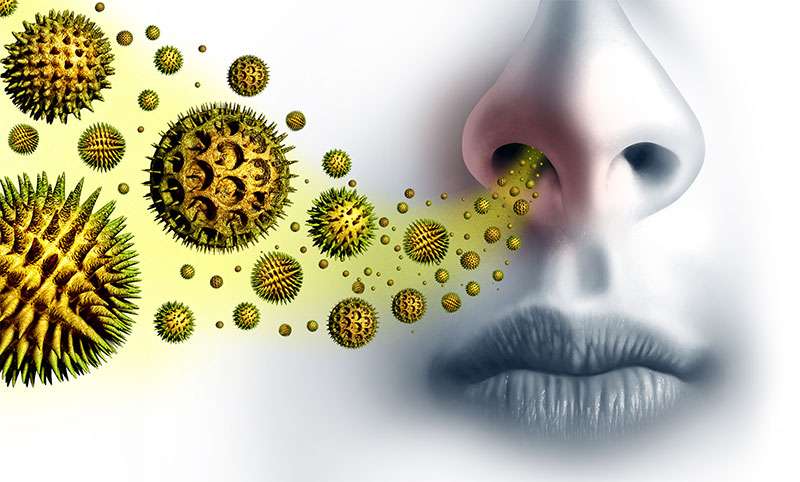Can Viruses Trigger Allergic Reactions?

This article examines the potential link between viruses and allergic reactions. It aims to explore the mechanisms by which viruses may trigger allergic responses in individuals. By understanding these interactions, we can gain insights into the common viral triggers of allergies and how they activate the immune system.
Furthermore, this article discusses the symptoms, diagnosis, and treatment options for viral-induced allergies.
Lastly, emerging research on the relationship between viruses and allergies is presented.
Key Takeaways
- Viral infections can lead to allergic sensitization, such as viral-induced asthma.
- Certain viruses act as adjuvants, enhancing the immune response to allergens.
- Viral infections release pro-inflammatory mediators, exacerbating asthma symptoms.
- Viral infections modify the immune response, making individuals more prone to allergies.
Understanding Allergic Reactions to Viral Infections
Allergic reactions to viral infections are a complex phenomenon that require further investigation to fully understand their underlying mechanisms.
Viral infections have been implicated in the development of allergic sensitization, leading to conditions such as viral induced asthma.
The relationship between viral infections and allergic sensitization is multifaceted and not yet fully elucidated.
It is hypothesized that certain viruses, such as respiratory syncytial virus (RSV) and rhinovirus, may act as adjuvants, enhancing the immune response to allergens and promoting allergic sensitization.
Other mechanisms include viral-induced damage to the respiratory epithelium, which may increase the permeability of allergens and facilitate their entry into the immune system.
Additionally, viral infections can lead to the release of pro-inflammatory mediators, promoting airway inflammation and exacerbating asthma symptoms.
Further research is needed to unravel the intricate interactions between viral infections and allergic sensitization, which would contribute to better prevention and management strategies for viral induced asthma.
The Link Between Viruses and Allergies
The potential association between viral infections and the development of respiratory hypersensitivity has been extensively investigated in scientific literature. Understanding viral mechanisms underlying the development of allergies is crucial for the development of new treatment approaches.
- Viruses can trigger the release of pro-inflammatory cytokines, leading to airway inflammation.
- Certain viral infections can increase the production of IgE antibodies, which play a role in allergic reactions.
- The presence of viral infections can modify the immune response, making individuals more prone to develop allergies.
- Viral infections can disrupt the integrity of the respiratory epithelium, making it more susceptible to allergens.
- Some viruses have been found to directly activate mast cells, which are involved in the allergic response.
These findings provide insight into the complex relationship between viral infections and allergies, and could potentially lead to the development of targeted therapies for individuals with viral-induced allergies.
Common Viral Triggers of Allergic Reactions
This discussion will focus on the phenomenon of viral-induced allergies, specifically exploring the mechanism behind allergic reactions and identifying viral triggers.
Viral-induced allergies occur when a viral infection triggers an immune response that leads to the development of allergic symptoms. Understanding the mechanism behind allergic reactions can provide insights into the complex interplay between viruses and the immune system.
Identifying viral triggers can help in the prevention and management of allergic conditions.
Viral-Induced Allergies Explained
Viral-induced allergies are caused by the immune system’s response to viral infections. These allergies can manifest in various ways, including viral-induced asthma and viral-induced rhinitis. Viral-induced asthma is characterized by asthma symptoms triggered by a viral infection, such as a cold or flu. This can lead to difficulty breathing, wheezing, and coughing. On the other hand, viral-induced rhinitis refers to inflammation of the nasal passages due to viral infections. This can result in symptoms such as sneezing, runny nose, and congestion.
To further illustrate the concept of viral-induced allergies, a table is provided below:
| Type of Allergy | Description |
|---|---|
| Viral-induced asthma | Asthma symptoms triggered by a viral infection |
| Viral-induced rhinitis | Inflammation of nasal passages due to viral infections |
Mechanism Behind Allergic Reactions
One of the key factors that contributes to the development of viral-induced allergies is the immune system’s response to viral infections. Understanding the immune response and allergic sensitization mechanisms is crucial in unraveling the mechanism behind allergic reactions.
When a virus enters the body, the immune system recognizes it as foreign and mounts a defense by activating various immune cells and releasing inflammatory molecules. This response is intended to eliminate the virus and restore homeostasis. However, in some individuals, this immune response can become dysregulated, leading to the development of allergic reactions.
The exact mechanisms behind this dysregulation are not fully understood, but it is believed to involve a complex interplay between genetic predisposition and environmental factors. Further research is needed to decipher the intricate mechanisms underlying viral-induced allergies and to identify potential targets for therapeutic intervention.
Identifying Viral Triggers
The identification of specific viral pathogens that are associated with the development of allergies is a significant area of research in understanding the etiology of these conditions.
Viruses are known to trigger allergic responses by stimulating the immune system and promoting an exaggerated immune reaction.
Several studies have suggested a link between viral infections and the onset or exacerbation of allergic diseases such as asthma and allergic rhinitis.
Respiratory viruses, including rhinovirus, respiratory syncytial virus (RSV), and influenza virus, have been identified as potential viral triggers for allergic symptoms.
These viruses can induce airway inflammation and enhance the production of pro-inflammatory cytokines, leading to the development of allergic responses.
Further research is needed to elucidate the specific mechanisms by which viral infections contribute to the development and progression of allergies, as this will aid in the development of targeted therapies and preventive strategies.
How Viruses Activate the Immune System in Allergy Sufferers
This discussion focuses on the virus-induced allergic responses and the activation of the immune system in individuals suffering from allergies.
It aims to explore the mechanisms by which viruses can trigger allergic reactions and how the immune system responds to these viral stimuli.
Virus-Induced Allergic Responses
Virus-induced allergic responses have been observed in various studies, indicating the potential link between viral infections and allergic reactions. One specific manifestation of this link is viral induced asthma, where respiratory viral infections can trigger asthma symptoms in individuals with pre-existing asthma.
The exact mechanisms through which viruses induce allergic responses are still not fully understood, but it is believed that the virus activates the immune system, leading to an exaggerated response to allergens.
Antiviral medications have been explored as a potential treatment for allergies, with the aim of reducing viral replication and subsequently decreasing the likelihood of developing allergic symptoms. However, the effectiveness of antiviral medications in treating allergies is still under investigation, and further research is needed to establish their role in managing virus-induced allergic responses.
Immune System Activation
Immune system activation plays a crucial role in the exaggerated immune response associated with viral infections and subsequent development of allergic symptoms. When a virus infects the body, it triggers the immune system to mount a response to eliminate the invader. However, in some cases, this immune response can become dysregulated, leading to the development of allergic symptoms.
Here are three ways in which viral infections can lead to an exaggerated immune response:
- Molecular mimicry: Viruses can produce proteins that mimic those found in the host’s own tissues. This can lead to the immune system mistakenly targeting its own tissues, resulting in allergic reactions.
- Cytokine storm: Viral infections can trigger an excessive release of pro-inflammatory cytokines, causing an overwhelming immune response. This can lead to tissue damage and the development of allergic symptoms.
- Immunological memory: After a viral infection, the immune system retains a memory of the pathogen. In some cases, this memory can lead to an overactive immune response upon subsequent exposure to allergens, contributing to allergic symptoms.
Understanding the mechanisms behind immune system activation during viral infections can provide insights into the development and management of allergic reactions.
Symptoms and Diagnosis of Viral-Induced Allergies
Symptoms of allergies triggered by viruses can include nasal congestion, sneezing, coughing, and itchy or watery eyes. These symptoms are similar to those seen in allergic rhinitis caused by environmental allergens. However, viral-induced allergies can also be accompanied by symptoms such as sore throat, fatigue, and low-grade fever. It is important to note that the presence of these symptoms alone does not confirm a viral-induced allergy, as they can also be indicative of other respiratory infections. Diagnosis of viral-induced allergies involves a thorough evaluation of the patient’s medical history, physical examination, and laboratory tests. A table summarizing the common symptoms seen in viral-induced allergies compared to other respiratory infections can aid in the diagnosis process:
| Symptom | Viral-Induced Allergy | Other Respiratory Infections |
|---|---|---|
| Nasal Congestion | + | + |
| Sneezing | + | + |
| Coughing | + | + |
| Itchy/Watery Eyes | + | – |
| Sore Throat | + | + |
This table can serve as a useful tool for healthcare professionals in distinguishing viral-induced allergies from other respiratory conditions based on the presence or absence of specific symptoms.
Treatment Options for Allergic Reactions Caused by Viruses
Viral-induced allergies can cause a range of symptoms, and their treatment primarily focuses on managing these symptoms.
The treatment options for allergic reactions caused by viruses include both pharmacological and non-pharmacological approaches.
Pharmacological interventions often involve the use of antihistamines, which block the effects of histamine, a chemical released during allergic reactions. Additionally, corticosteroids may be prescribed to reduce inflammation and alleviate symptoms.
Non-pharmacological approaches, such as avoiding triggers and using nasal saline rinses, can also be helpful in managing symptoms.
Preventive strategies play a crucial role in reducing the frequency and severity of viral-induced allergic reactions. These strategies may include practicing good hygiene, avoiding contact with known allergens, and getting vaccinated against viruses.
Adherence to preventive measures and seeking appropriate medical advice are essential for effectively managing viral-induced allergic reactions.
Preventing Viral Infections From Triggering Allergic Responses
Preventive measures play a crucial role in reducing the frequency and severity of allergic responses caused by viral infections. Allergic reactions triggered by viruses can lead to significant discomfort and health complications. It is therefore important to implement strategies aimed at preventing viral infections in order to minimize the risk of allergic responses.
One effective preventive measure is practicing good hygiene, such as frequent handwashing, to reduce the transmission of viruses. Additionally, ensuring the maintenance of a clean and sanitized environment can help prevent the spread of viral infections.
Vaccinations against specific viruses, such as the flu vaccine, can also be a valuable preventive strategy. By implementing these preventive measures, the incidence and severity of allergic reactions caused by viral infections can be significantly reduced, improving overall health and well-being.
Emerging Research on the Relationship Between Viruses and Allergies
Emerging research has shed light on the intricate connection between viral infections and the development of immune responses associated with allergies. This research has investigated the underlying mechanisms by which viruses can trigger allergic reactions and the potential long-term effects they may have on individuals.
To paint a picture for the audience, here are four key findings from recent studies:
- Viral infections can disrupt the immune system’s balance, leading to an overactive response to harmless substances, such as pollen or dust mites.
- Certain viruses can directly stimulate the production of specific antibodies that are also involved in allergic reactions.
- Viral infections can alter the composition of the respiratory tract, making it more susceptible to allergens and exacerbating allergic symptoms.
- Long-term effects of viral infections on the immune system can increase the risk of developing chronic allergic conditions, such as asthma or eczema.
These findings highlight the complex interplay between viral infections and the development of allergies, providing valuable insights for future prevention and treatment strategies.
Frequently Asked Questions
Are All Allergic Reactions Triggered by Viruses?
Allergic reactions can be triggered by a variety of factors, including viral infections. While not all allergic reactions are caused by viruses, certain viruses, such as respiratory syncytial virus and rhinovirus, have been implicated in the development of viral-induced allergies.
Can Viral-Induced Allergies Be Treated With Over-The-Counter Medications?
The effectiveness of over-the-counter (OTC) medications for treating viral-induced allergies is a topic of interest. Understanding the available options and their efficacy can provide valuable insights into managing these allergies without prescription medications.
How Can Someone Differentiate Between a Viral-Induced Allergy and a Regular Viral Infection?
Differentiating between viral-induced allergies and regular viral infections is crucial. Identification of specific symptoms, diagnostic tests, and medical history can aid in the accurate diagnosis. Treatment options for viral-induced allergies include over-the-counter medications and immunotherapy. Long-term effects on the immune system require further research.
Are There Any Vaccines Available to Prevent Viral Infections From Triggering Allergic Responses?
Preventive vaccines play a crucial role in reducing the allergenic potential of viral infections. These vaccines aim to prevent the onset of viral infections, thereby minimizing the likelihood of triggering allergic responses.
What Are Some of the Long-Term Effects of Viral-Induced Allergies on the Immune System?
Long-term consequences of viral-induced allergies on the immune system include immune system dysfunction. This dysfunction may manifest as altered immune responses, increased susceptibility to infections, and the development of autoimmune disorders.









